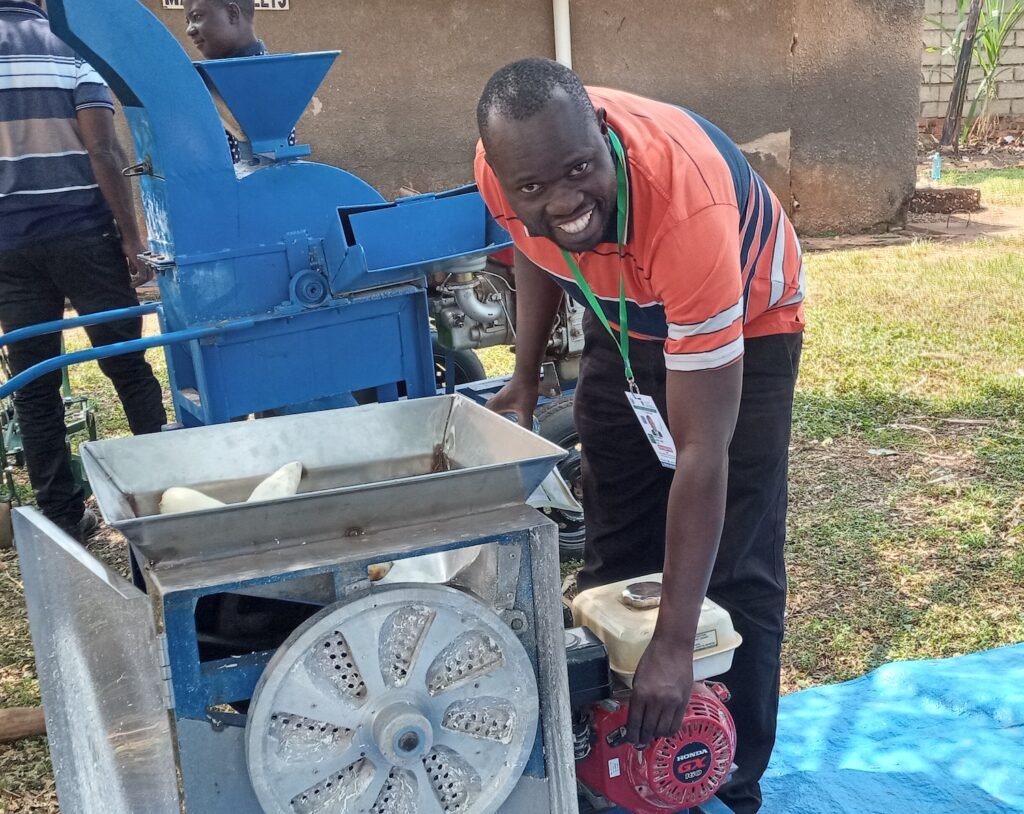By Panagri Media Correspondent
Uganda research institute tackles farmers’ agro-processing woes
On arrival, we notice relatively larger traffic to an area where farm machinery is on display, marking it out as a major attraction.
We learn it is the exhibition stand for the Agricultural Engineering and Appropriate Technology Research Center (AEATREC), one of the institutes of Uganda’s National Agricultural Research Organisation (Naro).
Administered under the National Agricultural Research Laboratories (NaRL) in Kawanda, the institute is mandated to generate and disseminate agricultural engineering technologies and innovations that enable farmers, cottage processors and value chain actors meet the production, processing and market demand.
The centre also provides testing, evaluation, standardisation and certification services of agricultural machines and equipment developed or imported by other players in the value chain.
At the Jinja showground, Ronald Walozi, an agricultural engineer and a research officer at AEATREC, is the one tasked with showing eager visitors to the exhibition stand, mostly small-scale farmers, some of agro-processing machinery recently produced by a team of scientists at the institute.
These include rice and soy threshers, maize shellers and a chipping machine for tuber crops such as cassava. These innovations, Walozi says, were inspired by challenges farmers faced with harvesting and drying their farm produce using the traditional method of cracking and putting out to dry under the sun.
The ordinary way of processing these products is labour-intensive, uniformity of the end product cannot be guaranteed and quality is a challenge.
“Usually before we develop a farm machinery in our workshop at Namalere, we do it according to farmers’ needs. This requires us to go the ground to interact with farmers in the various regions across the country to establish farmers’ needs and demands,” says Walozi. The AEATREC machinery are sold under different Naro brand names linked to the different crops they are designed to process.
NARO CAS-CHIP This is a food grade fresh cassava chipping machine designed to produce high quality cassava chips for human consumption and industrial use. Farmers usually place their order and
in one week the machine is developed. The machine produces uniform chips and is good for youth and women group enterprises engaged in cassava flour processing in the rural farming communities.
It takes about 1-2 days for chips to dry ready for grinding to process pure cassava flour as opposed to ordinary cassava processing that may build mould leading to poor quality flour. It has capacity to process 450-600kg of chips per hour using one litre of petrol and farmers are able to add value from pure cassava flour, including for baking confectionary products such as biscuits, cakes, bread and cookies.
Machine components include a petrol engine, inlet to receive peeled and fleshly washed cassava tubers, and the hipping unit which picks small chips. The frame belt allows and transmits power from the engine. One machine is sold at Shs4.5million and farmers are required to make 50 percent payments before the experts embark on developing the machine. NARO-SOY Thresher
This is a motorised thresher for threshing soybean developed to avoid challenges faced when threshing manually, leading to scattering of seed in untidy places. It is a recent machine, with the first developed in 2020 after demand was established among farmers growing soybean in Northern Uganda mainly in Acholi and Lango subregions. The machine has capacity to thresh whole dried soybean plant between 100-120kg per hour with one litre diesel.
It is normally operated by three people — one feeding the plant into the inlet, another operating the engine and the third collecting the dust and husks blown in an opposite direction.
The components include engine belt, threshing unit, input jute, dust/ husk jute, fan for blowing off the husks and the frame.
It costs UGShs6 million (USD1,637.14) and the payments terms are the same with the cassava chip.
NARO Light Weight Rice Thresher
It is a motorised rice thresher specifically designed for women and youth groups involved in rice production.
The output is 650-750kg per hour using one litre of petrol and it reduces physical grain loss during threshing from 4.5 percent to 0.1 percent. It weighs 138-150kg, making for easy hand pushing within. the rice field. When using it, the economic gain
from using the machine is estimated to be US$138 per hectare. The components include the engine threshing unit, tyres used for rolling it on farm since it is mobile It costs UGShs5 million (USD1,364.28) and is mostly used by farmers at Doho Irrigation Scheme in Butaleja District and those growing upland rice in Acholi and Lango sub-regions.
ASI Rice Thresher
This is a machine specifically designed for rice farms of at least 20 hectares or farmers growing rice in groups on large scale. The threshing output is 1,500-2,000 kg per hour.
Since it is slightly heavy, most farmers prefer to use oxen, power tiller or tractor to pull it on the farm.
NARO Hand Cranked Maize Sheller
It is a simple maize sheller designed for youth groups, those with vision impairment and physical disability and the elderly. It has a seat for
someone to use while pushing the maize into the shelling unit one by one. Its output is 60-80kgof cleaned maize grain per hour.
NARO FOR A-CHOP
This is a motorised machine designed to chop fodder for livestock. The chopped fodder can either be fed fresh or preserved as silage for future feeding. The machine has two models.
The Naro Fora- Chop-1 partially shreds forage into smaller pieces. The second model is Naro Fora-Chop-G, which performs both duties of chopping and grinding grain for livestock. It is mainly placed on wheels for ease of movement on the farm.
Its output is 500-600kg of fresh chopped forage for light duty and 1,500-1,600kg of fresh chopped forage for heavy duty per hour. The chopped fodder length varies from 25-50mm.


